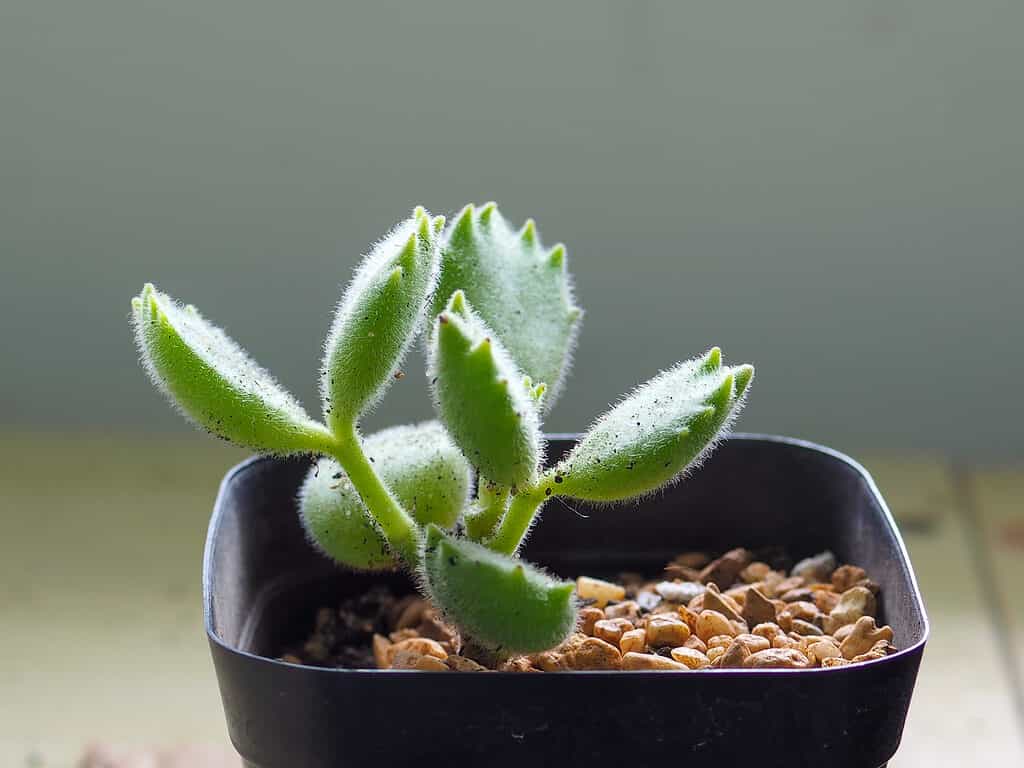Succulents come in various shapes and sizes, making them the perfect option for plant lovers. While there’s a lot of versatility across the 180-plus species of succulent, they tend to share some common characteristics. For one, most healthy succulents have compact rosettes. If your succulents are getting leggy, you may want to trim them to restore their ideal appearance.
Let’s explore how to trim leggy succulents without damaging them and restore these lovely plants to their former glory.
What Causes Leggy Succulents?
The term “leggy” refers to when a succulent stretches out, extending its stem and widening its leaves. Some refer to this process as “stretching.”
Legginess typically occurs when the succulent isn’t getting enough light. It starts to stretch upward and outward to increase its visible surface area to get more sun exposure.
This process is known as phototropic growth and is common among many types of plants. This reaction causes flowers to grow toward the sun (causing you to rotate your flower pots every few weeks for even growth).
The increased exposure to the sun aids with photosynthesis and nutrient production. In other words, your succulent is in survival mode and needs more light — ideally more than six hours daily.
If your succulent has been in the same pot for some time, its legginess could be related to a cramped root system. Consider repotting your succulents to a slightly larger pot at least every two years.

Leggy succulents extend their stems and widen their leaves to gain access to more sun.
©ReginaPivetta/Shutterstock.com
Can I Fix a Leggy Succulent?
Unfortunately, there’s no way to reverse legginess. Once your plant has stretched out, it will stay that way.
Trimming is the best option for correcting a leggy succulent. It’s also an opportunity to propagate your succulent to build your collection!

Trimming is the best option for correcting a leggy succulent.
©Karnwela/Shutterstock.com
How to Trim Leggy Succulents
Trimming leggy succulents is very easy. For this task, you’ll need clean, sharp scissors or pruning sheers, a fresh pot with well-draining soil, a mister, and rooting hormone (optional).
- Behead the succulent, leaving about an inch of stem attached.
- Gently pinch and tug a few leaves off the bottom of the rosette to expose some healthy stem tissue. Set these aside.
- Leave the beheaded succulent and pinched leaves in a safe area to callous over — they should not be in direct sunlight.
- Fill a shallow pot or pot tray and a larger pot with well-draining soil.
- After 2-3 days, lay the leaves horizontally on the soil in the shallow pot and poke the stem of the beheaded succulent into the larger pot. Use rooting hormone if you prefer.
- Mist both pots with a fine spray of water each day.
- After 2-3 weeks, give your succulent a gentle pull. If it resists, it has roots and is ready for full watering.
- Once you notice root growth on the leaves, you can transplant these to bigger pots.
This method of trimming a leggy succulent serves two purposes. First, you can cut back and save the original plant. Second, propagating a few leaves allows you to grow new plants as a security blanket if the beheaded succulent doesn’t take.
Depending on the type of succulent, you can also leave a few leaves on the original rooted stem to promote new growth. This doesn’t always work, but many plant parents succeed with this approach.
Naturally Leggy Succulents
Some succulents are naturally leggy and meant to stretch out or cascade over the pot. A few natural leggy species include:
- String succulents – the string of pearls, bananas, dolphins, etc., are all meant to be leggy and cascade out of their pot with space between the leaves.
- Burro’s tail – this trailing succulent also naturally stretches. However, the rosettes should remain compact.
- Aloe – this succulent naturally elongates and fans outward.
- Graptosedum – some cultivars of this succulent are naturally leggy and love to sprawl out.
Be sure to research your specific type of succulent to determine if it’s getting leggy or just loves to explore its surroundings.

Burro’s tail (
Sedum morganianum)gets its name from its fat green leaves hanging from a thin stem resembling a tail.
©Pickless/Shutterstock.com
Indoor Succulents vs. Outdoor Succulents
Indoor succulents are more prone to legginess than outdoor succulents, as the light exposure is more inconsistent. However, outdoor succulents can also get leggy.
The primary reason outdoor succulents get leggy is shade. Check your succulents’ surroundings to ensure there isn’t another pot or a larger plant casting them in shadow.
To trim leggy outdoor succulents, follow the steps above, and transplant your saved succulent outdoors after 2-3 months post-trim.
Do I Have to Trim a Leggy Succulent?
Trimming a leggy succulent isn’t necessary. If you don’t mind the look of it, you could leave it be.
However, it’s important to move your plant and ensure it’s getting the sunlight or room for root growth that it needs. Otherwise, it will eventually die. Also, extensive legginess can weaken the stem and put your succulent at risk of further harm.
The photo featured at the top of this post is © ReginaPivetta/Shutterstock.com
Thank you for reading! Have some feedback for us? Contact the AZ Animals editorial team.






